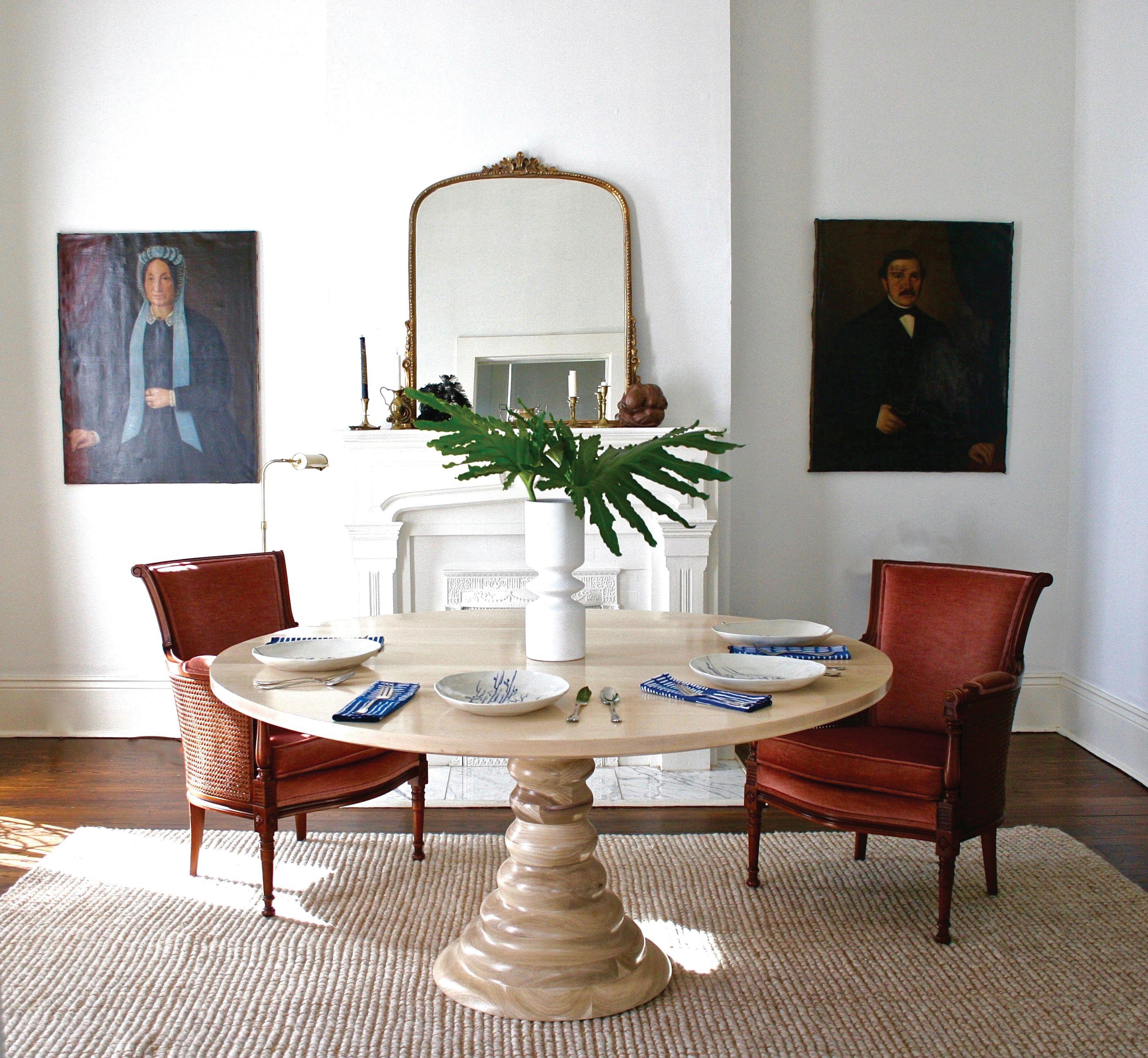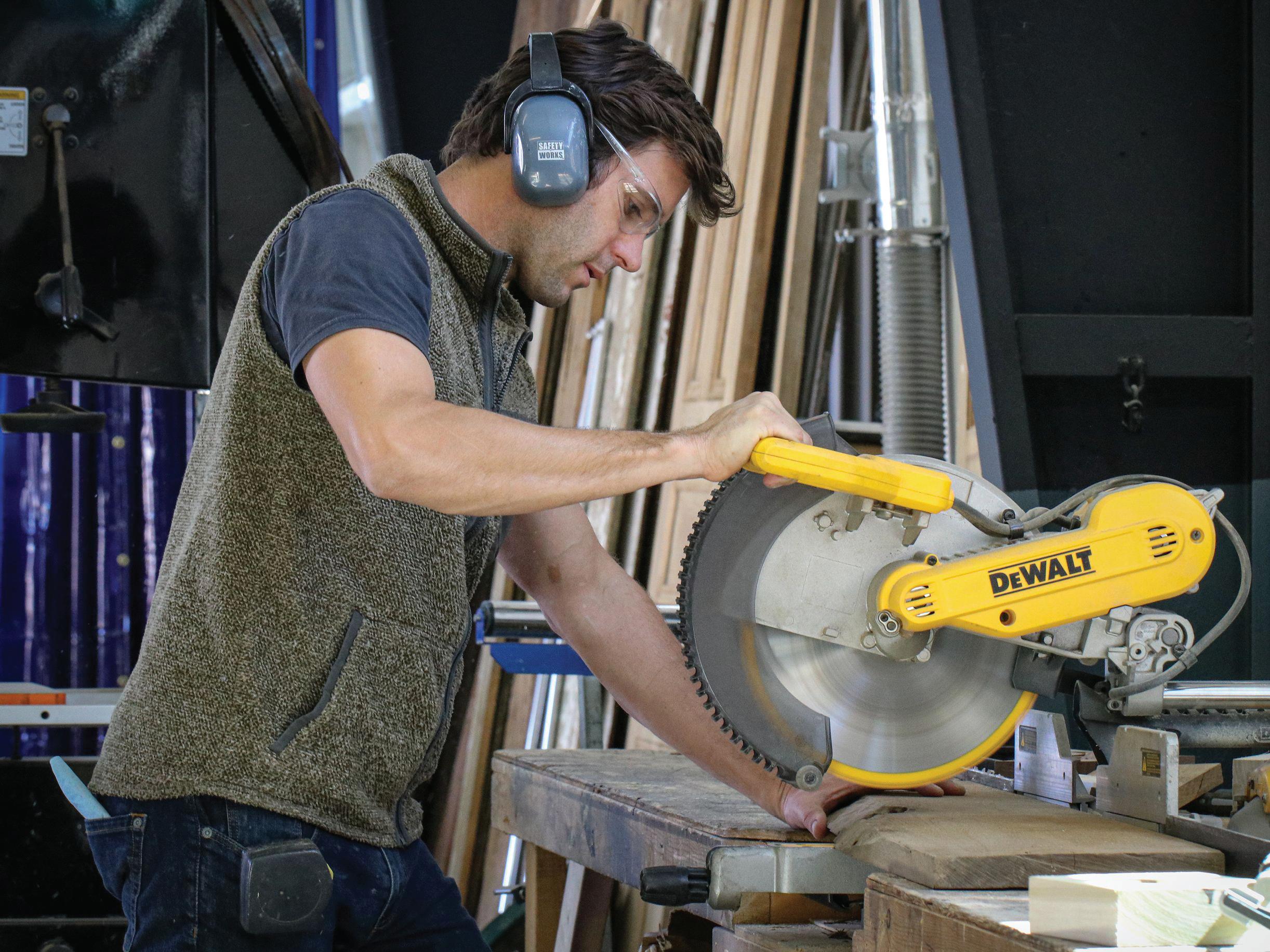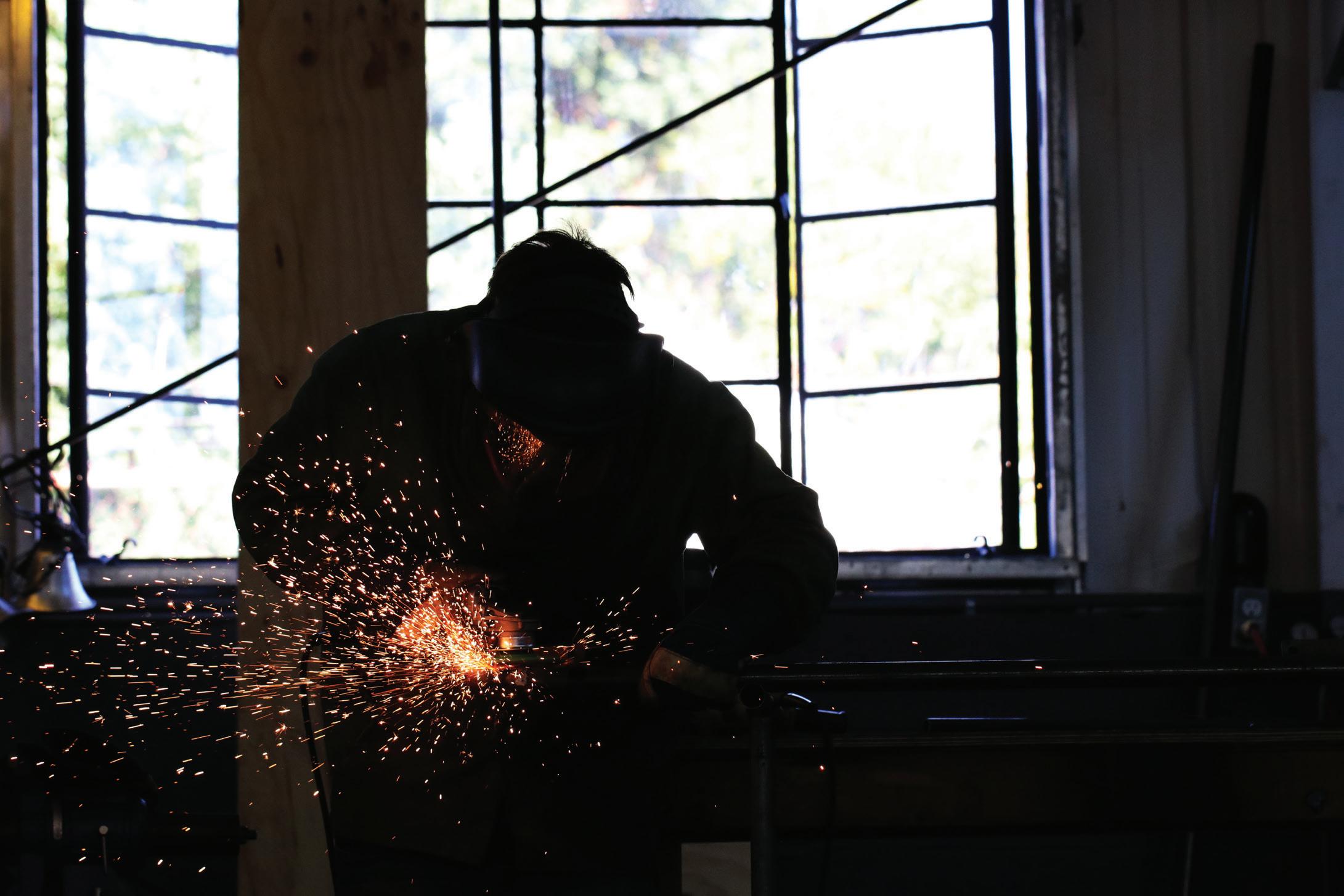
6 minute read
Doors of the Past
CONTEMPORARY FURNITURE INSPIRED BY REINCARNATION IN THE CRESCENT CITY
By Jordan LaHaye
From the rooftop of Doorman’s furniture workshop on the Westbank, there’s a great view of Old Man River. After 2005, when those waters so infamously broke through the levees to fill and ravage this Crescent City, the building––like so many others––was abandoned. So many structures, built both in and by the spirit of this strange and wondrous city, were bent, crumbled, drowned. And then left behind as the people who had inhabited them started over on higher, firmer ground.
On one particular of the many shotgun homes so fated, a door survived and eventually made its way into the creative, if inexperienced, hands of a young Alex Geriner in 2008. The resilient old cypress door, salvaged from the ruin, received a new life as Geriner’s headboard. A friend of his was drawn to the combination of style and story and asked if he would make her one too. Subsequently, Geriner decided to try his luck with the then-newfangled marketplace of Etsy.com. He salvaged more doors, built more beds, and within a week of posting them online, had shipped two to California.
“The whole country at that point knew about Katrina and what had happened here,” said Geriner. “It was kind of this powerful, yet spiritual, thing where you’re taking a crisis and a lot of tragedy, and taking the pieces from that tragedy and giving them new life.”
The Etsy shop eventually evolved into a larger endeavor, launching officially as Doorman Designs in 2013 (and rebranding as simply “Doorman” in 2019). Today, with a team of eight full-time employees, the boutique operation functions as one of New Orleans’ only furniture companies where all of the pieces are designed and manufactured in-shop.
Producing everything from beds to tables to credenzas in a uniquely contemporary interpretation of styles nevertheless quintessentially New Orleans, Doorman centers its identity around this city as its original source of material and inspiration.
“We’re living in a three-hundredyear-old city,” said Geriner. “It’s hard not to be inspired. You can’t just overlook the house you’re living in, the stores you go into. There’s just tons of history, tons of layers.”
In addition to the mysticism surrounding New Orleans’ refurbished wood, Geriner deeply appreciated the opportunity to build high quality furniture sustainably. “Personally,” he said, “I’ve always held the belief that we are here for a finite amount of time, and this planet just doesn’t belong to us. We’re sort of renting the space while we are here, and we need to be really respectful and polite of it. When I started building this furniture, I definitely recognized the magnitude of reducing your carbon footprint by using something that has already been in use.” However, today—fifteen years after Hurricane Katrina—quality old wood is a rarer, more sought-after commodity. While Geriner and his team still make it a priority to use it when they can, the business has grown to require more resources than what they can source from salvage. “The materials we work with are now often new woods, mostly sourced from around the Southeast,” said Geriner. “But sustainability is still at the forefront of all we do.” Since their move to this new workshop in 2019, Geriner has been slowly shifting all of production to be powered by solar panels, predicting that they will be about 75- 90-percent solar powered by August.
An online-only company, Doorman has never had a retail space and currently claims to have sent work to every continent except for Antarctica. Still, “New Orleans is our hometown market, our biggest market. They’ve really come out over the years to support us,” said Geriner.
Noting the increased shift to digital commerce, especially lately, Geriner admits to the benefit of perfect timing. “When I started doing this by myself in 2009, the idea of buying a piece of furniture sight-unseen online was an uphill challenge.

Doorman is one of New Orleans’ only furniture companies in which all of the products are made totally in-house and by hand. The eight-person team includes welding fabricator Tristan Aubrey (top) and founder Alex Geriner (bottom).
Photos courtesy of Doorman

People didn’t want to spend a lot of money on something they could only see in photographs. Nowadays, most of our transactions are made over a smartphone.”
However, Doorman does embrace in-person engagement, offering tours of their workshop to customers and the general public. On my visit to the echoing warehouse, smelling of fresh sawdust and mountained by stacks of wood planks, an extendable version of the company’s signature “Amelia” table in walnut stood half finished at the doorway— stunningly rich and large on its two familiar, though still statement, tapered pedestals. In the far corner, lead carpenter Jesse Varichak was cutting out rough-edged circles of wood, which would later be layered, carved, and smoothed into that same elegant pedestal shape—reminiscent of the way water radiates in concentric rings where you drop a penny in it— for an iteration of the original Amelia Round Dining Table.
One of the company’s newest pieces, the Audubon Pedestal Table, similar to the Amelia, but—as Geriner describes it—with a “more coastal, retro 1970s vibe, Scandinavia-meets-California chic” look, stood ready to be shipped to Washington D.C.
The metalworking section of the shop was darker, the machines loud and the fires hot. The iconic iron panels of New Orleans’ balconies and front porches were miniaturized and fragmented, stacked in piles throughout the room—to be applied to “Eleanor Console Sideboards” and “Piety Iron Console Tables.” As with the wood, Geriner used to use exclusively antique ironwork—“but now, we mostly use reproductions. When we first started building these pieces, you could find those old ones. These days, you’re lucky if you can find them unbroken, if you can find them at all.”

Doorman’s “Josephine” Bed, pictured at the Henry Howard Hotel in New Orleans.
Photo by Kathleen Fitzgerald.
There is still one set of Doorman furniture that is exclusively made from reclaimed wood, though, said Geriner. The Earhart Modern Swivel Bar Stools, with their three metal mid-centuryesque legs, are topped with a wooden seat: “Barge board,” said Geriner. “This stuff doesn’t exist anywhere except for in New Orleans.” Showing me some raw planks of it, stacked up against the wall, he pointed out the rustic, battered sections of the wood, holes throughout. The barebones for many of New Orleans’ oldest homes, this wood saw duty as part of a barge— or rather, raft—carrying Americans down the Mississippi to New Orleans after the Louisiana Purchase. “Think Huckleberry Finn,” said Geriner. “Really crude. A family would ride on it with everything they had: their livestock, maybe some grain, corn. Whatever they needed to get them from Philadelphia or New York to New Orleans.” Then, once they arrived, they’d take their noble steeds apart and build their houses with them.

Doorman’s “Earhart” Modern Swivel Barstools are all made with Bargeboard, a salvaged New Orleans-specific wood that can be traced back to Americans’ post-Louisiana Purchase journeys down the Mississippi River to the Crescent City, which they took on “barges” or rafts.
Photo courtesy of Doorman
“I tell my customers who buy these—this fourteen-inch piece of wood … it’s been a tree,” said Geriner. “It’s been a boat. It’s been a house. And now it’s your barstool. It’s the power of reincarnation, over and over again.”
Over the past ten years, Geriner has also kept a close eye on the changes in interior trends, and has worked to adapt his work to reflect them—“though we aren’t selling our creative souls down the river.” With the instance of reclaimed wood, he explained, “if you think back five or ten years ago, Restoration Hardware was putting out some really rustic stuff, that shabby farmhouse look. It’s changed. People don’t want banged up rustic tables. They want things with some rustic qualities, but overall more streamlined, more sophisticated, more clean. But still with a bit of personality. Like our barstools— the wood tells the story. It’s just a modern sort of tripod legged stool, accompanied by this really storied piece of wood.”
And the story comes full circle, said Geriner, who describes the privilege of working so close to the river as “a bit like a pilgrimage.” It is, after all, the very road that brought so much of New Orleans’ foundations, its wood, here. And, of course, it is the very same force that brought so much of it to the ground, and the same that watched it—aided it, even—in rising back up, in reincarnating, once again.










